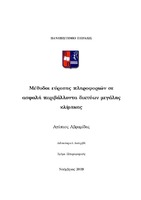Μέθοδοι εύρεσης πληροφοριών σε ασφαλή περιβάλλοντα δικτύων μεγάλης κλίμακας

Doctoral Thesis
Author
Αβραμίδης, Αγάπιος
Date
2011-09-23View/
Subject
Ηλεκτρονικοί υπολογιστές -- Δίκτυα -- Μέτρα ασφαλείας ; Peer-to-peer architecture (Computer networks) ; Information networks ; Information technology -- Security measuresAbstract
This dissertation addresses the problem of searching for data organized in a large, highly transient network of nodes. We propose techniques that conform to the requirements for scalability of peer-to-peer (P2P) networks and contribute to the searchability and the security of state of the art P2P architectures, such as structured overlay networks (SON). This is accomplished by extending the search operation of SON to support range queries and by proposing a security infrastructure for SON implemented on top of the peers of the overlay network. In particular, we study current P2P systems and related technologies in terms of their search and routing mechanisms. We provide a brief history of the evolution of P2P systems that lead to the current generation of P2P systems that meet the requirements of decentralization, reliability, scalability and describe the most representative protocols of SON. We describe the requirements for searching in SON. In particular, we argue that the queries must support multiple attributes over a range of data values. We analyze the weaknesses of SON that prevent the direct implementation of the aforementioned search requirements and briefly survey some solutions. Then, we focus on the range query problem and provide a solution by proposing a replication scheme for the keys of the data items being stored in the system. All the key replicas are organized into a binary tree structure, named Replication Tree (RT). The novelty of RT over similar mechanisms lies on the fact that RT does not enforce a limit on the number of key replicas per tree node. Instead, RT provides the replica management policy and let the peer nodes to enforce it whenever is necessary. Thus, RT efficiently exploits the capabilities of the peer nodes. Furthermore, we survey the security issues in structured overlay networks and provide a distributed Public Key Infrastructure (PKI) infrastructure which is built upon the Chord overlay network, in order to provide security services for the peer nodes. Finally, we explore the potential of another distributed technology, Grid Computing. Despite their differences, both P2P and Grid Computing have similar goal, the sharing of computing resources. By designing a digital library according to the service-oriented architecture, which is based on the OGSA specifications, we explore and evaluate the capabilities of grid technologies and investigate common problems both in P2P and Grid.


